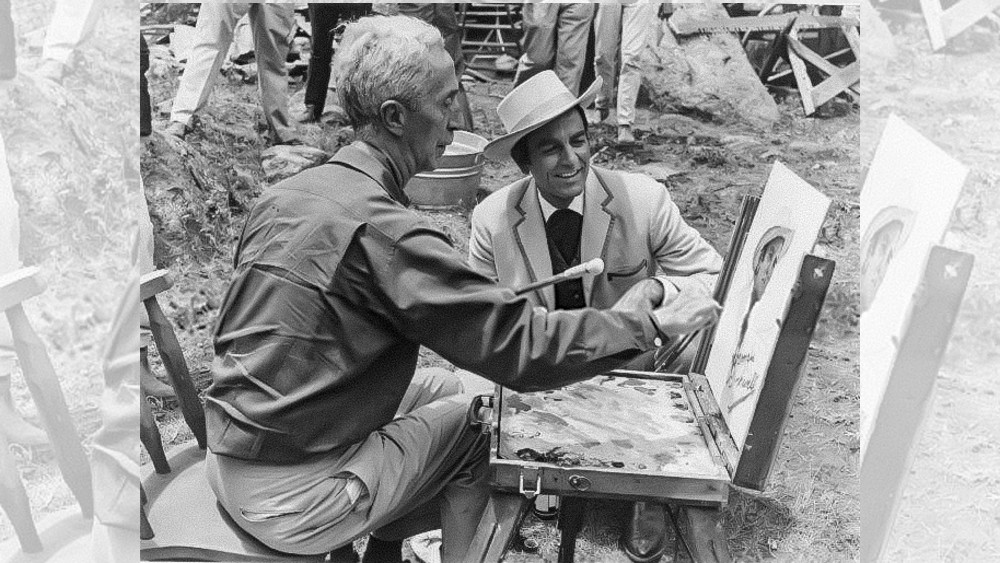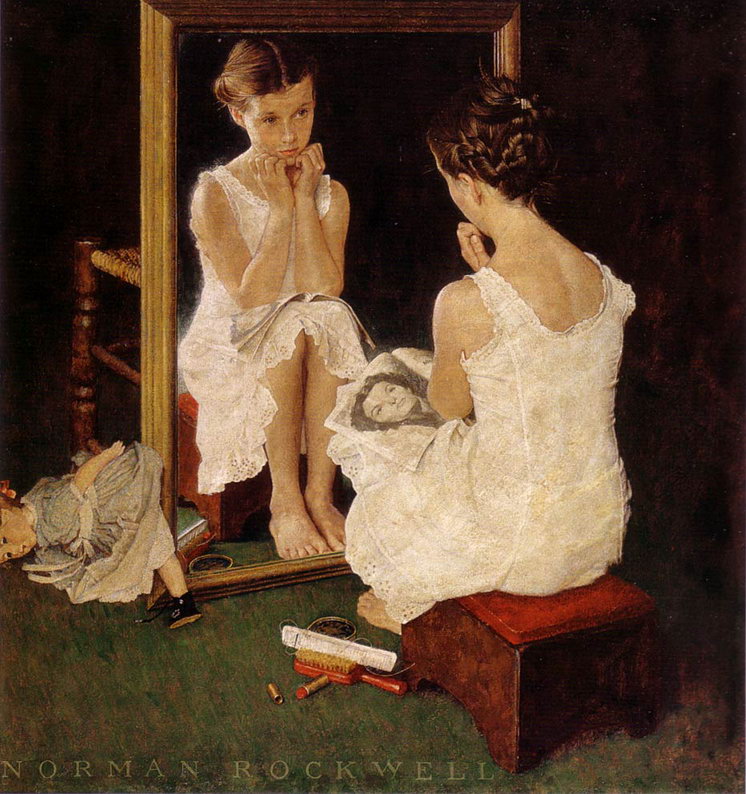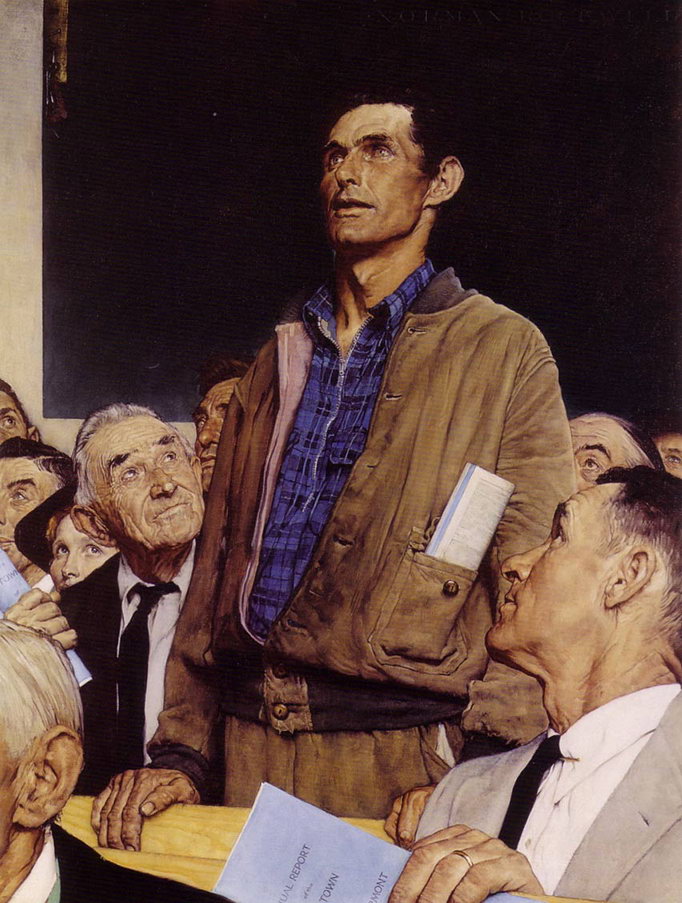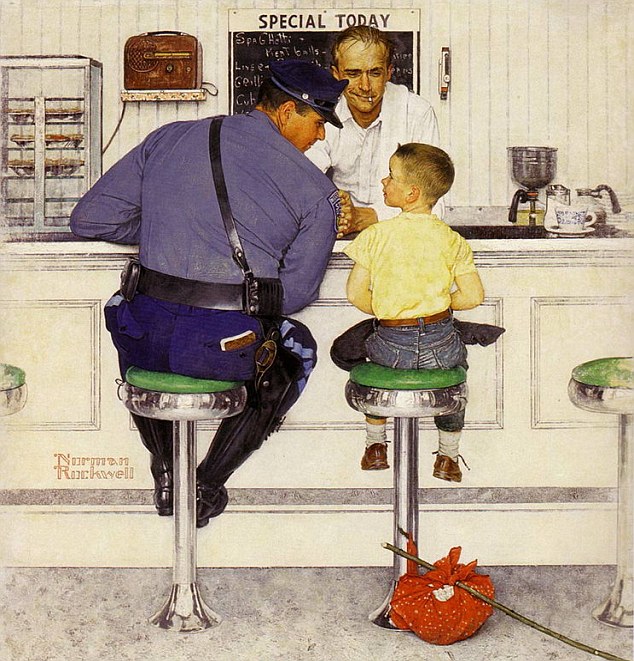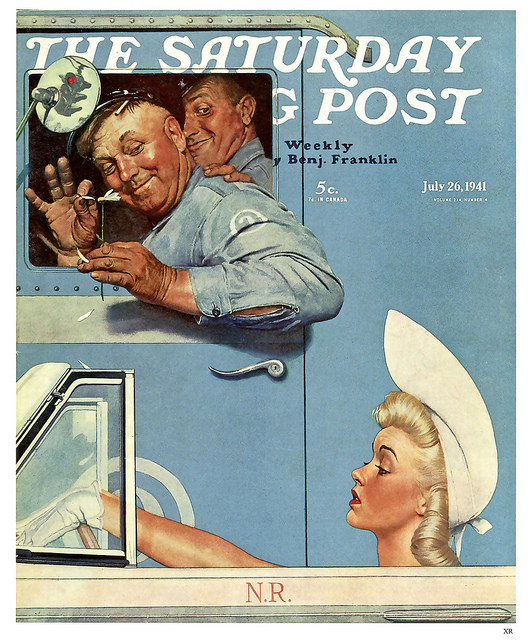When it comes to Norman Rockwell (“nudge, nudge”), homosexuality is in the eye of an obsessed culture
Back in the day, the Monty Python team was famous not only for its nonsense (“Dead Parrot” anyone?) but also for its edgy, modern, topical humor. One of their most famous (and irritating) sketches was the “nudge nudge, wink wink” sketch, made all the way back in 1971 (officially known as the “Candid Photography” sketch). In it, Eric Idle played one of those awful people who believes that every word spoken is a double entendre about sex. His character was both annoying and pathetic, as he responded to everything the stodgy, proper Terry Jones said with a leering “nudge, nudge, ya’ know what I mean?”
In 1971, that was still pretty ground-breaking stuff. Before the 1960s, while people were thinking about sex, as people have done since time immemorial, most of them, barring New York sophisticates bathed in Freud and Kinsey, weren’t talking about it yet at cocktail parties or with strangers in pubs. The 60s changed all that. I vividly remember a family friend who pressed on my father a small book purporting to show that Madison Avenue had taken the famous “sex sells” dictum (pretty women in ads for everything from cars to cigars) and brought it to a whole new level with “subliminal” sexual images. When you thought you were looking at a glass of Bacardi’s with ice, you were really seeing a subliminal image of a naked woman writhing sinuously in your rum — never mind that this invisible woman was missing three limbs and a breast.
By the end of the 1970s, the “everything is about sex” mentality had been mainstreamed. One of the teachers who occasioned the most nervous laughter at my high school was the woman who insisted that Maurice Sendak’s Where the Wild Things Are had achieved its iconic status, not because it showed a little boy safely acting out the frustration children so often feel in a grown-up world, but because Sendak had included couples copulating in the trees that are the backdrop to every image in the book. If you didn’t see them, you weren’t looking hard enough.
Of course, once you’ve mainstreamed sex to the extent that everything is all about sex, you end up with blasé teenagers, instead of twittering, quivering, young sexual acolytes. So where do you go from there? Simple. Everything is about gay sex. That’s how gay activists manage to get headlines. One of their big headlines was the claim that Lincoln was gay. Their “proof” was less compelling than the certainty with which they expressed it: in an era when it was the norm for men to have close male friendships and, when traveling, to share beds at inns, Lincoln had close male friendships and shared beds at inns. If they could, the activists would have written QED after that one, not to mean quod erat demonstrandum, but instead to mean “queer everyone [who’s] dead.”
The most recent entry in the “if he’s a famous dead man, he must have been gay” approach to biography is Deborah Solomon’s American Mirror: The Life and Art of Norman Rockwell. Since Solomon spent a large part of her career at the Wall Street Journal, I’ll let that publication describe her premise:
Deborah Solomon starts her new biography of Norman Rockwell, “American Mirror,” with a joke the artist once told his therapist about a man who wants to marry an elephant. Unattainable love proved a powerful theme in the artist’s life, says Ms. Solomon. Her book’s theory: Repressed sexuality, fear of women and fascination with manhood made Rockwell’s art brilliant and his personal relationships troubled.
The 56-year-old New York writer spent more than a decade on Rockwell. This wasn’t a painter of family life, she argues, but a man seeking comfort outside conventional relationships. Of Rockwell’s 322 covers for the Saturday Evening Post, only three depict a traditional family of parents and at least two children, she says, adding that his paintings instead largely feature boys and men.
[snip]
Is your book basically saying that Rockwell was a latent homosexual?
I’m not a shrink, and I really don’t speculate about a life and a person’s psychology as a writer. As a critic, I can say when I look at his work I feel it’s possible to discern enormous homoeroticism as well as a desire to distance himself from his own desires. In his life, he did prefer male company. It was a special kind of sexual ambivalence that he may not have acted on. Do I think he had homosexual relationships? No. He goes camping and shares a bed with his assistant Fred Hildebrandt and the next morning he said, “Fred looked fetching in his pajamas.” He was very comfortable around men and he loved male bodies.
There’s more, but you get the idea. Rockwell wasn’t actually gay . . . but he wanted to be. In addition to the “I think he’s gay” stuff in the above interview, Solomon wrote other things in her biography that show a woman with sex on her brain. The most bizarre theory comes when she discusses one of Rockwell’s more charming paintings. It show a little girl on the cusp of adolescence, seen from the back, staring into a mirror. She’s thrown her doll aside, and is longingly comparing her still childish face with a photograph of Jane Russell:
You and I see the moment a girl leaves her childhood behind and starts preparing to function (and compete) in the world of adult women. Solomon saw something very different:
‘Actually,’ says Solomon, ‘seen from the back, she could be a boy.’ And the girl’s doll, tossed on the floor? ‘A bizarrely sexualized object. With her right hand buried in her petticoats, the doll could almost be masturbating.’
Wow! They do say that, to a hammer, everything is a nail, and I guess to a New York sophisticate everything is about sex (the more deviant the better), but that really is taking the whole thing to extremes. I’m surprised Solomon didn’t throw in something about drag queens and cross dressing.
Solomon doesn’t stop with the gay subtext of little girls. She also takes a stab at analyzing Rockwell’s famous “freedom of speech” painting:
You and I see a man free to stand up in his community and speak his mind. Solomon sees “out and proud”:
Her take on Freedom of Speech is that the man standing is ‘unattached and sexually available. Unbuttoned and unzipped.’
It seems as if Solomon’s take on the matter is like a parlor game. “Pick a picture, any picture, and I can spot the gay subtext.” Rockwell’s world is no longer one of small town innocence and all-American charm. It’s a shadowy world of cross-dressing boys, men advertising their wares for sale to other men, and even predatory pedophiles. What!? Predatory pedophiles? Yes, indeedy. Take that famous picture of a cop sitting at a soda fountain next to small boy who has, at his feet, the stereotypical early 20th century symbol of an innocent runaway: a bundle of clothes wrapped in a handkerchief tied to stick.
You and I see the cop using folksy charm to get the clearly well-cared for child to head back home, as the man behind the counter smiles at the scene playing about before his eyes. Solomon sees something sleazy:
In The Runaway, a painting of a burly cop and a little boy on adjacent cafe stools, the cop leans toward the boy ‘as if to emphasize the… tenderness that can form between a grown man and a little boy… the hint of homo-eroticism’ she writes.
No doubt were Solomon to analyze “Two Flirts” (one of my favorite Rockwell paintings), she would assure us that the fact that there are two men in the truck means that they are indeed homosexual (after all, one of them is touching the other one), and that their blatant ogling at the pretty blonde is their way of trying to pass for straight in a homophobic society:
Solomon made only one mistake when she decided to “gay up” Norman Rockwell. She forgot that there are people still alive who knew the man. Unlike Lincoln, who had no one left behind to speak about him when the “Lincoln is gay” theory hit the airwaves, Rockwell still has living children and grandchildren, and they are not pleased to see their relative painted as a depressed and repressed homosexual. They’ve issued a strong public statement challenging the book. Intelligently, they’ve attacked myriad provable errors in the book, rather than just saying, childishly, “She’s wrong. Nyah-nyah-nyah.”
The Norman Rockwell Family Agency, in light of today’s New York Times review of American Mirror the Life and Art of Norman Rockwell, is compelled to finally address the many analyses of Norman Rockwell. The Norman Rockwell Family Agency is making this final statement:
Many of the reviews of Deborah Solomon’s American Mirror The Life and Art of Norman Rockwell have accepted her account of his life and work. Her account is essentially wrong. She has neglected or misused the sources which she cites. Her use of Norman Rockwell’s autobiography, My Adventures as an Illustrator, is highly selective. As Professor Patrick Toner of Wake Forest University states in his online review on First Things.com, “Solomon has a pronounced tendency to either distort or simply ignore evidence to the contrary.”
Garrison Keillor states in today’s review, “She does seem awfully eager to find homoeroticism – poor Rockwell cannot go on a fishing trip without his biographer finding sexual overtones. Keillor comments on Solomon’s suggestion that the doll in “Girl at Mirror” could be masturbating, “Well, I suppose that Michelangelo’s “David” could “almost” be masturbating”.
On page 94 of her book, Solomon describes how Rockwell would “hang about the schools at recess . . and stop little boys on the street . .” She then comments, “Today with our awareness of pederasty scandals (meaning pedophilia) this kind of behavior might seem problematic . .” She then omits a passage just below this in the Autobiography that fully explains what really happened – after Rockwell would convince a boy to pose, they would go to ask the mother’s permission. On page 101 she comments on his relationship with his models: “The integrity of the boys was never in question. But his own character was not nearly so straightforward.” Referring to Nabokov’s novel, Lolita, Solomon writes, “In a way Rockwell was Humbert Humbert’s discreet and careful twin brother, roused by the beauty of children but (thankfully) more repressed.” Many of the reviewers have ignored the claim of pedophilia, perhaps because the suggestion of it blows the credibility of the book out of the water.
She supports this unfounded claim with another phantom theory, that Rockwell was a closeted homosexual. To link pedophilia and homosexuality in this way is offensive and clearly homophobic. We have found at least 68 of these sexual references throughout the book. On page 168 she comments on his search for costumes for his models: “. . . he did enjoy acquiring clothing from men who caught his eye, as if it were possible to acquire the less tangible parts of them as well.” Solomon now claims that sex is only a “tiny part” of her book. But sex is a major theme of the book and her phantom theories color and distort everything, including Rockwell’s entire character and her interpretations of his art. There is no way to separate her sexual theories from the rest of the book. Her take on Freedom of Speech is that the man standing is “unattached and sexually available. Unbuttoned and unzipped.” Solomon also omits from the Autobiography many accounts of Norman Rockwell’s feelings and relationships with women.
There are also many other factual errors and omissions — we have found at least 96. Again, this is something that few reviewers seem to notice — they simply do not know enough about Norman Rockwell’s life, and are too dependent on Solomon’s flawed account. She inadequately interviewed Rockwell’s three sons and therefore her account of his life is often inaccurate. She gives an incomplete account of a significant difficulty with the Post when the art editor, Ken Stuart, painted out a horse from one of NR’s covers without consulting him. Solomon omits Norman Rockwell’s difficulties when his abilities were failing — in one instance he painted portraits of the Ross Perot family and they were so badly done that Mr. Perot sent them back and NR returned his check.
Most important of all, Solomon doesn’t understand the man, who Norman Rockwell was as a person. She says “On most days he was lonesome and loveless.” This is absurd. He did not mope, was not a chronic depressive, or a hypochondriac. He went through his trials and storms as we all do, but he was someone who ultimately affirmed life. People liked Rockwell and enjoyed being with him. He was interested in people and what they had to say. On a personal note, “I always had a wonderful relationship with my father, we were especially close when I helped him with his Autobiography.”
Solomon claims that her book is based on an examination of his art and that Norman Rockwell painted mostly men and boys. We counted all the Post covers from 1916 – 1951 and all the early covers for Life and Literary Digest. There are 172 covers with girls and women, and 141 covers with boys and men. Her theory is demonstrably wrong. Norman Rockwell also did 9 covers of Santa Claus. We’re not sure in which category Solomon would place Santa.
We are troubled and mystified that the Norman Rockwell Museum at Stockbridge has endorsed the book.
This is our last word, we are no longer going to participate in the drama Solomon has created. This book says a lot more about Deborah Solomon than it does about Norman Rockwell.
Thomas Rockwell and Abigail Rockwell
For The Norman Rockwell Family Agency
Cynthia DeMonte, 917-273-1717
[email protected]
The most telling error the Rockwells expose is the way Solomon asserts that Rockwell’s famous post covers gave short shrift to women, something that a simple count proves wrong: “Solomon claims that her book is based on an examination of his art and that Norman Rockwell painted mostly men and boys. We counted all the Post covers from 1916 – 1951 and all the early covers for Life and Literary Digest. There are 172 covers with girls and women, and 141 covers with boys and men. Her theory is demonstrably wrong.” That one deserves a true QED.
Our society’s obsession with homosexuality is not healthy. It leads us to pervert history, science, and the values that hold a society together. I know I sound homophobic when I say this, but I’m not. When I attack American Jews who have replaced the Torah with the Democrat Party platform, I don’t see myself as being either antisemitic nor self-loathing. I believe, instead, that I am pointing out ugly mutations in a culture that, when not mutated, is a health contributor to the world. I believe the same is true of those who reside on the lesbian, gay, bisexual, transgender, and questioning spectrum, a spectrum that is a very small part of the larger range of human sexual behaviors.
I don’t doubt that some people (such as the ones who died in Soviet gulags and Nazi concentration camps because of their sexuality) are emphatically gay, much as others are emphatically straight. I also believe that there are lots of people who could go either way. They’re not bisexual insofar as they do not choose to go both ways simultaneously. Instead, at a certain point in their sexual development, they look at a lifestyle and pick the sexuality that goes with it. In the old days, social pressure said to men, “Pick the wife, two kids, and the house in the suburbs.” By the late 1970s and pre-AIDS 1980s, when I was watching the gay revolution play out in San Francisco, an enticing social option to men with fluid sexuality said “Pick the lifestyle that allows you 100 orgasms per night” (which was precisely what was going on in the bathhouses that were such vectors for the spread of AIDS. The queer culture, with its press to be included in American education, is trying to revamp the 1970s and early 1980s pressure regarding gay sexual orientation.
We are an unhealthy culture when we force the brilliant Alan Turing, who may well have been the most important factor in winning World War II, to chemically castrate himself, a penalty (combined with public humiliation) that drove him to suicide. We are an equally unhealthy culture when the prism through which we view ourselves paints everything — and I do mean everything — in terms of a sexual orientation that encompasses at most ten percent of the population (and, quite probably, far less than that). A healthy, moral society protects the outliers from discrimination, but it must shape its values around the norm. In our case, the norm is that big bulge in the bell curve that is heterosexuality.
Freud gave Americans permission to talk about sex, all kinds of sex. At the same time, and long before Bill Clinton re-sexualized cigars, Freud is reputed to have warned that, at least sometimes, a cigar is just a cigar.
Image: Norman Rockwell and Mike Connor, 1966. Public domain. Other pictures used in this post fall under Fair Use.
